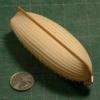-
Posts
13,302 -
Joined
-
Last visited
Content Type
Profiles
Forums
Gallery
Events
Everything posted by druxey
-
This reconstruction is fascinating! Nice going, Dick.
- 263 replies
-
- nave tonda
- round ship
-
(and 2 more)
Tagged with:
-

Holding small parts for soldering
druxey replied to BETAQDAVE's topic in Metal Work, Soldering and Metal Fittings
A silver soldering trick I learned from a jeweler was to use soft iron wire to hold the parts. This may 'stick' a bit, but it does the trick nicely! -
Thank you for the definition. It reinforces the idea that all wildlife in Oz is out to kill you! Thank you for educating us non-Australians.
-
Sorry to read about your circumstances. Hope power is back soon and things improve.
- 1,208 replies
-
- great republic
- clipper
-
(and 1 more)
Tagged with:
-
I won't argue with you about the sizes of 32 and 24 pounders, Siggi, but those 12 pounders on the quarter deck look much too large. Why would anyone want to paint the truck rims black? The paint would mark up the decks that they kept scrupulously clean. It is not logical. As for my comments about paint, my understanding was that lower decks were whitewashed, as there was limited light - my comment has nothing to do with any personal preference! Yes, I've seen blue painted inner bulwarks on contemporary models (also blue-grey and grey-green), but only in cabin areas. I stand to be corrected in my remarks.
-
I have reservations about the Royal George sectional model. If you look carefully, the trucks of the guns have black iron rims - something that would never have been the case on shipboard guns. Only land-based batteries would have had iron-shod wheels. Secondly, there appears to be no difference in size between the lower deck battery, presumably 32 pounders, and the guns above. The quarter deck guns were 12 pounders - they should be considerably smaller. The inboard paint scheme is questionable, too. The model has been 'improved' by obviously 20th century labels. What else might have been improved or altered as well?
-
Thanks for the explanation and giving me both a useful expression as well as a smile for the day!
-
Reworks often work much better, John! BTW, what is the origin of the expression 'a Claytons update'? Seems like a useful phrase to have on hand.
-
Good going, though, Steven. The size of the assembly against the monster match is impressive.
-
Just catching up on your opus magnum, Marc. Very impressive 'digging' for accuracy of reconstruction. I am curious about one thing, though - the lower gun deck: why would it need so many scuppers? As it is below the weather deck, surely the ship was not that wet?
- 2,696 replies
-
- heller
- soleil royal
-
(and 9 more)
Tagged with:
-
Well done, Samson! She looks lovely now.
- 39 replies
-
- kdy 15 juniorbad
- yacht
-
(and 2 more)
Tagged with:
About us
Modelshipworld - Advancing Ship Modeling through Research
SSL Secured
Your security is important for us so this Website is SSL-Secured
NRG Mailing Address
Nautical Research Guild
237 South Lincoln Street
Westmont IL, 60559-1917
Model Ship World ® and the MSW logo are Registered Trademarks, and belong to the Nautical Research Guild (United States Patent and Trademark Office: No. 6,929,264 & No. 6,929,274, registered Dec. 20, 2022)
Helpful Links
About the NRG
If you enjoy building ship models that are historically accurate as well as beautiful, then The Nautical Research Guild (NRG) is just right for you.
The Guild is a non-profit educational organization whose mission is to “Advance Ship Modeling Through Research”. We provide support to our members in their efforts to raise the quality of their model ships.
The Nautical Research Guild has published our world-renowned quarterly magazine, The Nautical Research Journal, since 1955. The pages of the Journal are full of articles by accomplished ship modelers who show you how they create those exquisite details on their models, and by maritime historians who show you the correct details to build. The Journal is available in both print and digital editions. Go to the NRG web site (www.thenrg.org) to download a complimentary digital copy of the Journal. The NRG also publishes plan sets, books and compilations of back issues of the Journal and the former Ships in Scale and Model Ship Builder magazines.


